Guitar pedals, commonly known as effects pedals, have become an integral component of a guitarist’s setup, transforming and enhancing the sound of the guitar in diverse ways. The history of guitar pedals was born from the need for innovation in guitar sound during the 1960s, these compact devices revolutionized music, granting artists the ability to personalize and shape their tone. From subtly coloring the sound to creating entirely new sonic landscapes, effects pedals have allowed guitarists to express their creativity beyond the constraints of the acoustic guitar’s natural sound.
The landscape of guitar effects is highly diversified, comprising a vast range of pedals that serve different functions; distortion, delay, reverb, and chorus are just a few examples of the effects that these pedals can produce. Each pedal manipulates the electrical signal from the guitar in unique ways to achieve its effect, offering musicians the capability to tailor their sound to fit various genres and styles. As technology has advanced, so has the complexity and versatility of effects pedals, allowing for innovations such as multi-effects units that combine several effects in one device.
The journey and evolution of guitar pedals denote a continuous quest for new sonic possibilities. From the earliest, rudimentary fuzz boxes to the complex digital processing units available today, guitar effects pedals have played a pivotal role in shaping the history of modern music. They have not only defined the soundscapes of countless legendary recordings but have also empowered musicians to explore uncharted territories of musical expression.
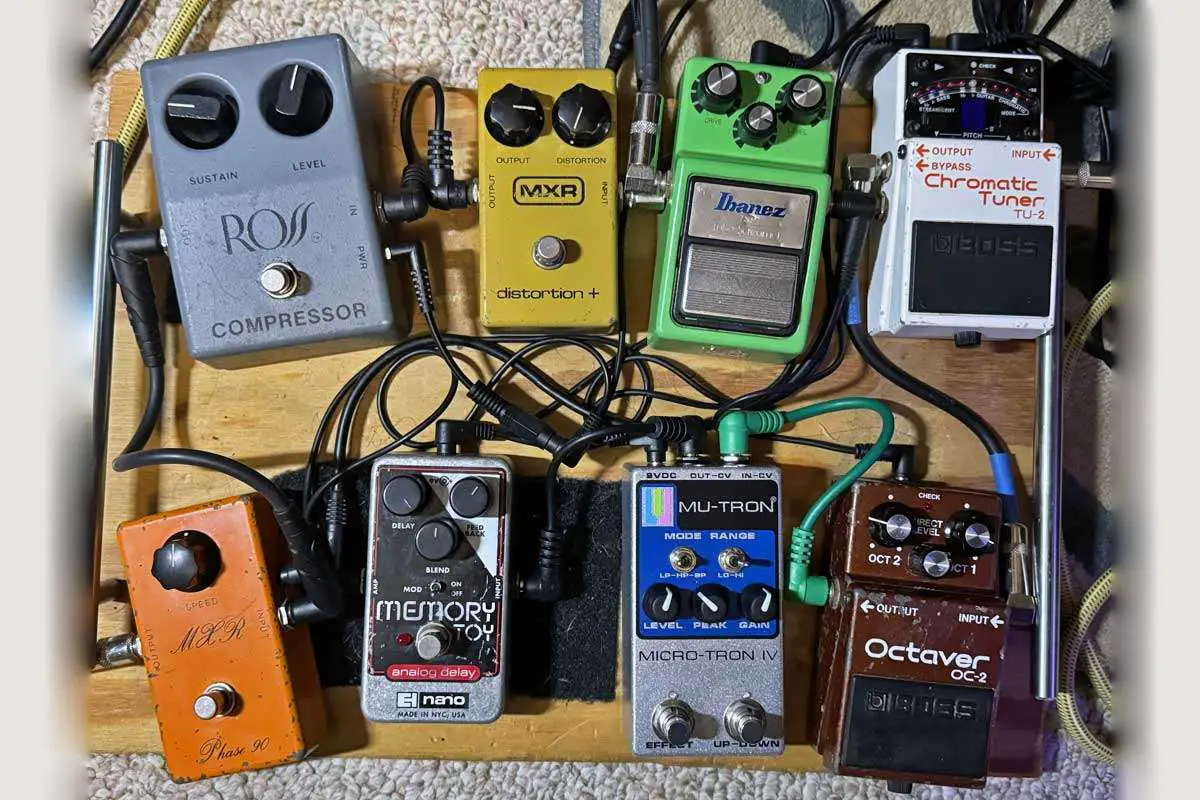
Origins of Guitar Pedals
Guitar pedals revolutionized music by enabling guitarists to shape and color their sound in innovative ways. This transformative period in music history saw the merging of electronics with musical expression.
Related: The History of The Electric Guitar
The Birth of Electronic Effects
As electric guitars gained prominence, the need for volume and sound variety paved the way for electronic effects. The first effects were built into amplifiers, including reverb and tremolo. These developments were the precursors to the standalone units recognized as the progenitors of the modern guitar pedal.
Key Innovators
Les Paul and Chet Atkins were pivotal figures in the adoption of electronic effects, experimenting with their guitars to create new sounds. Ray Butts and Paul Bigsby contributed significant innovations, the former with the echo effect and the latter with effects that would lead to the development of pedals. Meanwhile, Bo Diddley was one of the first guitarist to popularize the use of effects with his signature rhythmic innovation.
Early Commercial Models
Rickenbacker released one of the first known effects units in 1939 which could be considered a predecessor to the modern pedal. Subsequently, Maestro introduced the Fuzz-Tone, famously used by Keith Richards in the Rolling Stones’ “Satisfaction.” The invention of the transistor marked a pivotal moment, making compact guitar effects units technically and economically feasible.
Evolution of Effects Pedals
The progression of guitar effects pedals is a storied element of modern music, evolving from simple fuzz effects to an expansive array of sounds that defined various musical eras.
1960s: The Rise of Fuzz
The 1960s witnessed the dawn of the fuzz pedal, altering the rock ‘n’ roll soundscape. The Fuzz Face, famously utilized by Jimi Hendrix, became iconic for its distinctive growling distortion. Gibson’s Maestro FZ-1 Fuzz-Tone, featured in the Rolling Stones’ hit “Satisfaction,” triggered a surge in popularity for the fuzzy, gritty tones that became characteristic of the era’s rock sound.
Related: Best Fuzz Pedals For Starters
1970s: Diversification and Expansion
This decade marked a proliferation of effects. Wah pedals, like the Vox Wah, offered expressive voice-like sweeps, and Phase Shifters, such as the Uni-Vibe, provided a shimmering modulation. The 1970s also saw the introduction of the Electro-Harmonix Big Muff Pi, a defining fuzz distortion pedal. Companies like Univox expanded the landscape with effects like the Uni-Vibe, which offered a rich, swirling sound. Moreover, spring reverb tanks became a staple in amplifiers, enhancing the sonic depth with their reverb effect.
1980s Onwards: Digital Domination
Digital technology revolutionized effects pedals in the 1980s and beyond. Bucket brigade chips allowed for compact and intricate delay and chorus circuits, leading to the development of pedals like the Electro-Harmonix Memory Man. The use of digital signal processing enabled clear and precise echo and reverb effects, offering a wider range of adjustability. Multi-effects processors began to surface, combining multiple effects in a single unit, which were previously only available as individual analog pedals. The digital transition not only included the replication of classic analog effects but also brought about innovative sounds that shaped the music of the era and beyond.
Iconic Pedals and Their Sounds
Guitar pedals have shaped the sound of popular music by allowing guitarists to modify their tone. This section explores key developments in fuzz, wah and volume effects, as well as time-based effects.
Fuzz and Distortion Milestones
Fuzz pedals, which first gained popularity in the 1960s, are crucial for the gritty, saturated tones heard in classic rock. The Maestro Fuzz-Tone FZ-1, which gained fame from its use in The Rolling Stones’ “(I Can’t Get No) Satisfaction,” was one of the first widely produced fuzz pedals. Another notable pedal, the Fuzz Face, is renowned for its association with Jimi Hendrix and its distinctive round, red enclosure. In the realm of distortion, the Big Muff Pi is an essential pedal developed by Electro-Harmonix that offers a sustaining and rich harmonic distortion.
Development of Wah and Volume Effects
The wah pedal became a game-changer for guitar expressiveness. The original Cry Baby Wah and the Vox Clyde McCoy Wah allowed players like Jimi Hendrix and Eric Clapton to create the vocal-like, expressive sounds that became part of their signature styles. Meanwhile, volume pedals provided a different type of dynamic control, swelling in and out of notes without altering the tone.
Related: Best Wah Pedals For Beginners
Time-Based Effects: Echo, Reverb, Delay
Delay and reverb effects have been employed for creating atmospheric soundscapes since the early days of electric guitar. The EchoPlex tape delay was instrumental in producing the echo effects of the 60s and 70s. These days, digital delay pedals like the TC Electronic Flashback provide a wide range of delay types from crisp repeats to warm, analog-voiced echoes. Reverb pedals allow guitarists to simulate the acoustics of different spaces, from tight rooms to vast halls. Time-based effects have transformed the guitar from a purely rhythmic instrument into a source of sonic experimentation.
The Artists and Their Impact
The profound influence of guitarists on the evolution of music through their innovative use of pedals has shaped genres and defined the iconic sounds of big bands and solo artists alike.

Groundbreaking Guitarists
- Jimi Hendrix: Pioneering the use of the wah pedal, Hendrix offered a revolutionary approach to electric guitar, particularly in tracks like “Voodoo Child.”
- Eric Clapton: His work in songs like “I Feel Free” showcases the early adoption of the wah pedal, significantly affecting the direction of rock music.
Guitarists like Robin Trower and David Gilmour also harnessed pedal technology, creating ethereal sounds that define their unique musical styles. The use of the Rickenbacker guitar by both Trower and The Rolling Stones’ Keith Richards further exemplified how instruments and effects evolve together.
Signature Sounds and Classic Tracks
Eddie Van Halen’s distinct sound in the hit “Eruption” demonstrates the transformative power of guitar pedals, specifically through his usage of phaser and flanger effects. Similarly, Jimmy Page’s work on classic Led Zeppelin tracks incorporated innovative pedal techniques, cementing his position as a versatile and influential guitarist.
- “Whole Lotta Love” by Led Zeppelin is notable for its iconic pedal-driven sounds.
- The Edge from U2 is renowned for creating soundscapes with his rhythmic delays in “Where the Streets Have No Name.”
Through their signature sounds and classic tracks, these musicians not only popularized certain pedals but also inspired countless others to experiment with their own sound.
The Pedal Revolution in Bands
The integration of guitar pedals into band settings, from big bands to modern groups like The White Stripes, fronted by Jack White, led to a broadening of tonal possibilities and sonic landscapes. The prominence of pedals allowed bands like Pink Floyd and Nirvana to craft atmospheric and gritty textures, respectively.
- Pink Floyd: The band, with Gilmour at the helm, elevated the electric guitar into new realms of expression, especially noted in albums like “Dark Side of the Moon.”
- Nirvana: Kurt Cobain’s raw distortion and feedback techniques provided the grunge movement with its characteristic angsty and powerful sound.
The Rolling Stones and Rocket 88 contributed to the rich history of electric guitar effects, with their use of early distortion techniques that would eventually lead many musicians towards dedicated effects units.
Modern Guitar Pedals
Modern guitar pedals have undergone significant transformations, influenced by technological advances, a burgeoning boutique market, and the proliferation of multi-effects and software solutions. These contemporary devices bear testament to a deep cultural and sonic evolution within guitar playing.
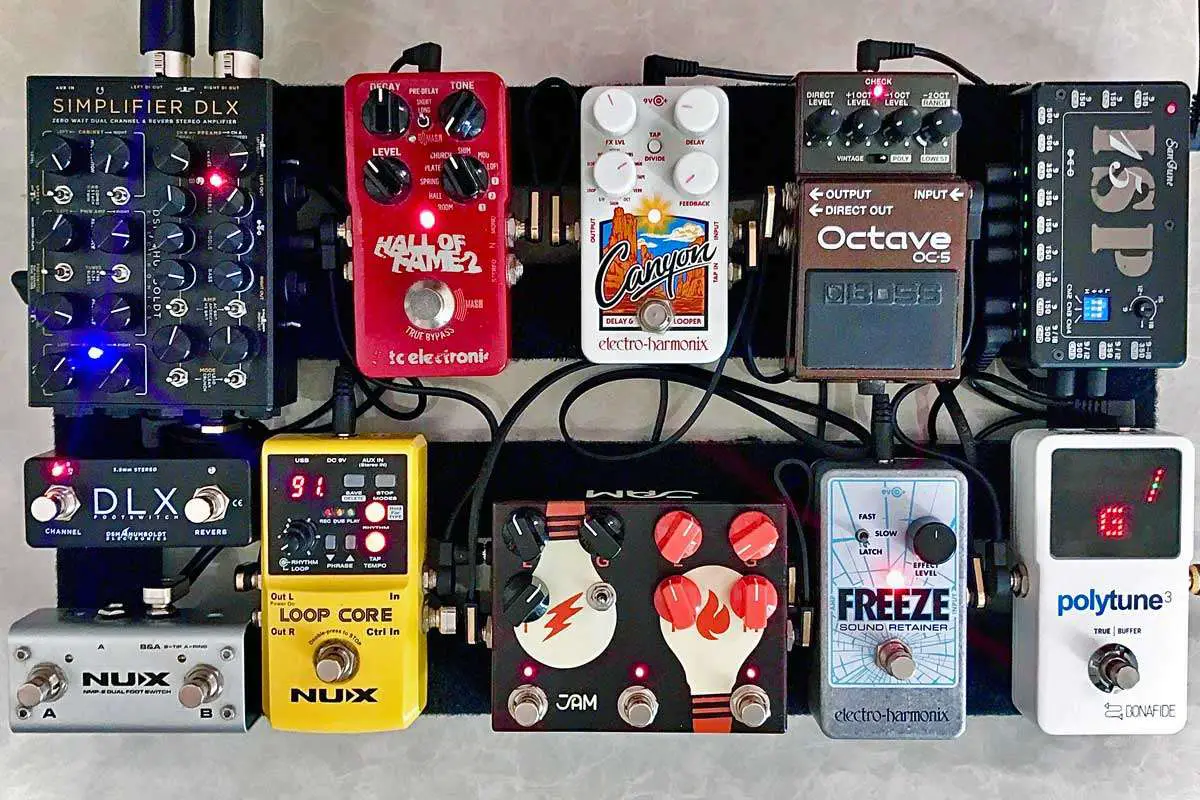
Advancements in Technology
The technology behind guitar effects pedals has seen a paradigm shift, largely due to the progression from germanium to silicon transistors. This transition has granted pedals higher stability with less sensitivity to temperature changes. Companies like Boss and Electro-Harmonix have been at the forefront, introducing digital effects that have expanded the sonic possibilities far beyond traditional stompboxes. Digital effects employ complex algorithms to create sounds that analog circuits cannot, ranging from precise modulation effects to ambient reverbs.
Transition in Transistors:
- From germanium to silicon
- Enhanced stability and durability
Influence of Digital Technology:
- Development of complex algorithms
- Expansion of sonic possibilities beyond analog
The Boutique Pedal Boom
The boutique pedal market has flourished as players search for unique tones and custom functionalities. Small manufacturers have capitalized on the demand for hand-built pedals often utilizing rare components to create distinctive distortion and modulation effects. Certain pedals like the Arbiter Fuzz Face have achieved iconic status and are sought after for their classic sounds, which were integral to the music of seminal artists.
Boutique Pedals:
- Emphasis on unique tones and craftsmanship
- Small-scale production with high-quality components
Iconic Models:
- Arbiter Fuzz Face: Classic sound revered by musicians
The Rise of Multi-Effects and Software
Multi-effects units and software plugins represent the all-in-one solution for the modern guitarist. These devices combine numerous effects in one package, often with the ability to emulate classic guitar amps and pedalboards. The octave pedal, once a standalone unit, now often features as part of a wider array of effects within these digital powerhouses. The practicality of having a full spectrum of tones accessible via one device or program has changed the way guitarists interact with technology both live and in the studio.
Multi-Effects Units:
- Combine numerous effects in a single device
- Can emulate classic amps and effects
Software Solutions:
- Offer extensive tweakability and convenience
- Have transformed home recording and live performance setups
Related: The best starter multi-effect pedals
Impact on Music and Culture
Guitar pedals have reshaped the soundscape of countless musical genres and have become an integral part of guitar culture and musicians’ identity. Their usage has also extended into popular media, influencing cultural perceptions of music and musicianship.
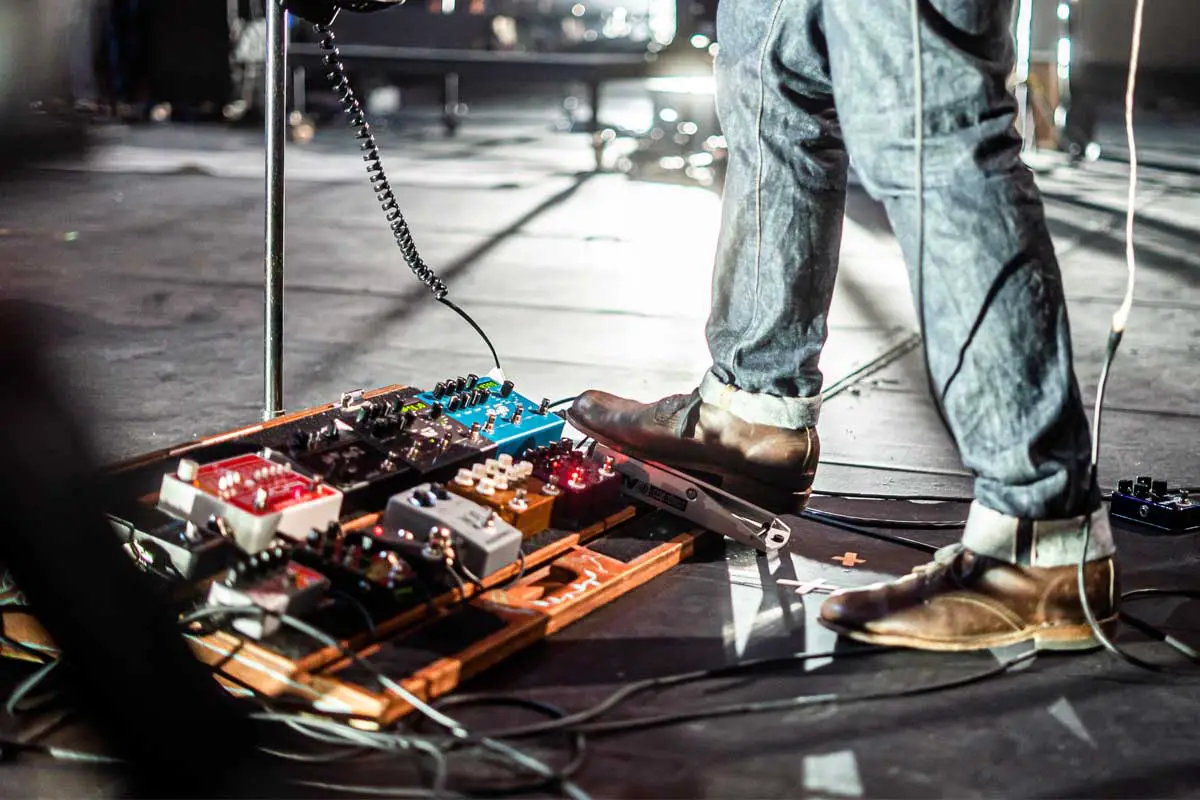
Influence on Music Genres
Guitar pedals, particularly those that create distorted sound, have been pivotal in the evolution of rock music and have also left their mark across multiple genres. Historically, distortion began as a fad, but rapidly became a staple, characterizing the gritty tones of blues-rock, the heavy riffs of metal, and the ambient landscapes of shoegaze. Guitarists and musicians have leveraged the tonal diversity of pedals to develop unique sounds that define and push the boundaries of their respective genres.
Contribution to Guitar Culture
Pedals have grown from simple utility devices to cultural icons in guitar culture. They are accessories through which guitarists showcase their technical prowess and aesthetic preferences. Collecting pedals has become as much a part of a guitarist’s pursuit as developing their playing skills. The pedal steel guitar, for instance, not only represents a musical instrument but also reflects a deep interconnection with the history and culture of music, particularly within country and western genres.
Guitar Pedals in Popular Media
In popular media, guitar pedals have emerged as symbols of the musician’s craft. Documentaries, films, and music videos often feature close-ups of pedal boards, projecting an image of sophistication and hinting at the musician’s potential for plectic influence. The communicative power of guitar pedals is also highlighted in YouTube product reviews, where the interactivity between the user and the pedal showcases the diversity and impact of effects on guitar sound and by extension, on modern music consumption.
Collecting and Maintaining Guitar Pedals
Guitar pedals, integral to the vast soundscape of modern music, have cultivated a dedicated following with collectors often seeking out vintage effects pedals for their unique tonal qualities. Maintenance and DIY contribute significantly to the longevity and performance of these pedals, while the culture of modding allows for personalized sound exploration.
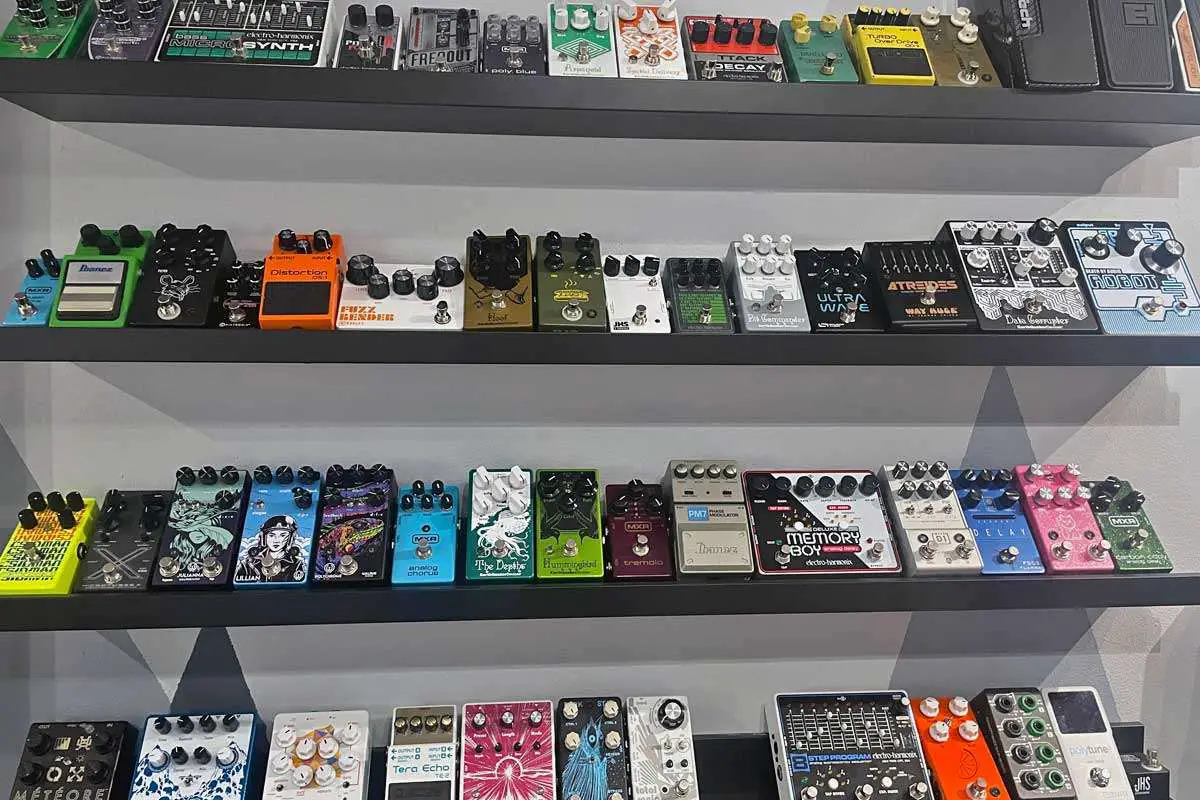
Collectors and Vintage Market
Collectors of guitar pedals treasure the rich history and distinctive sounds that vintage effects pedals bring. They are fascinated by the nuances that these antiquated devices add to their setup, with certain rare models fetching high prices on the market. These enthusiasts meticulously study the pedigree of pedals, often tracing them back to famous guitarists or seminal music events. Condition, rarity, and originality play significant roles in determining the value, making the vintage guitar pedal market a niche but vibrant segment of the music equipment industry.
- Rarity: Rare pedals, like the original Uni-Vox Uni-Vibe, command a premium.
- Condition: Mint condition items are more valuable; even with slight wear if they’re fully functional.
- Originality: All-original parts, without modifications, maintain the pedal’s value.
Maintenance and DIY
Maintaining guitar pedals is crucial for preserving their functionality and ensuring the quality of the guitar effects. Guitar effects maintenance involves regular cleaning, proper storage, and timely replacement of components like jacks and potentiometers. The DIY ethic thrives among pedal owners, with many opting to repair and maintain their equipment themselves. This hands-on approach not only extends the pedal’s life but also provides a deeper understanding of how various changes affect the overall sound.
- Cleaning: Frequent dusting and contact cleaner sprays can prevent crackling noise.
- Storage: Keeping pedals in a temperature-controlled environment reduces wear.
- Repairs: Simple soldering skills can save a trip to the repair shop for loose connections.
Pedal Modding Culture
Pedal modding culture has grown from the desire to either restore vintage effects to their former glory or to push the boundaries of what a pedal can offer. Pedal mods can range from simple tweaks to optimize noise performance to extensive redesigns that transform the pedal into a wholly unique unit. The community often shares their modding experiences and techniques online, fostering an environment of collaborative innovation. They alter electrical components for more durability or better sound quality, experimenting with sustenance, timbre, and bypass functionalities.
- Sound Tweaks: Altering capacitors can modify tone; changing clipping diodes can adjust distortion levels.
- Durability Mods: Upgrading switches and electronic parts can improve lifespan and reliability.
- Aesthetic Mods: Custom knobs and painted casings personalize the pedal’s appearance.
Throughout these subsections, the focus remains clear: guitar pedals are not just tools but pieces of history, capable of being customized to the individual artist’s needs while necessitating careful upkeep to preserve their sonic legacy. The commitment of collectors and the ingenuity of the modding community continue to fuel the enduring relevance of guitar pedals in modern music.
History of Guitar Pedals & The Future
In the ever-evolving landscape of guitar effects, advancements in technology and shifts in music production constantly shape the future of guitar pedals. They stand poised to become more innovative, integrated, and indispensable in modern music.
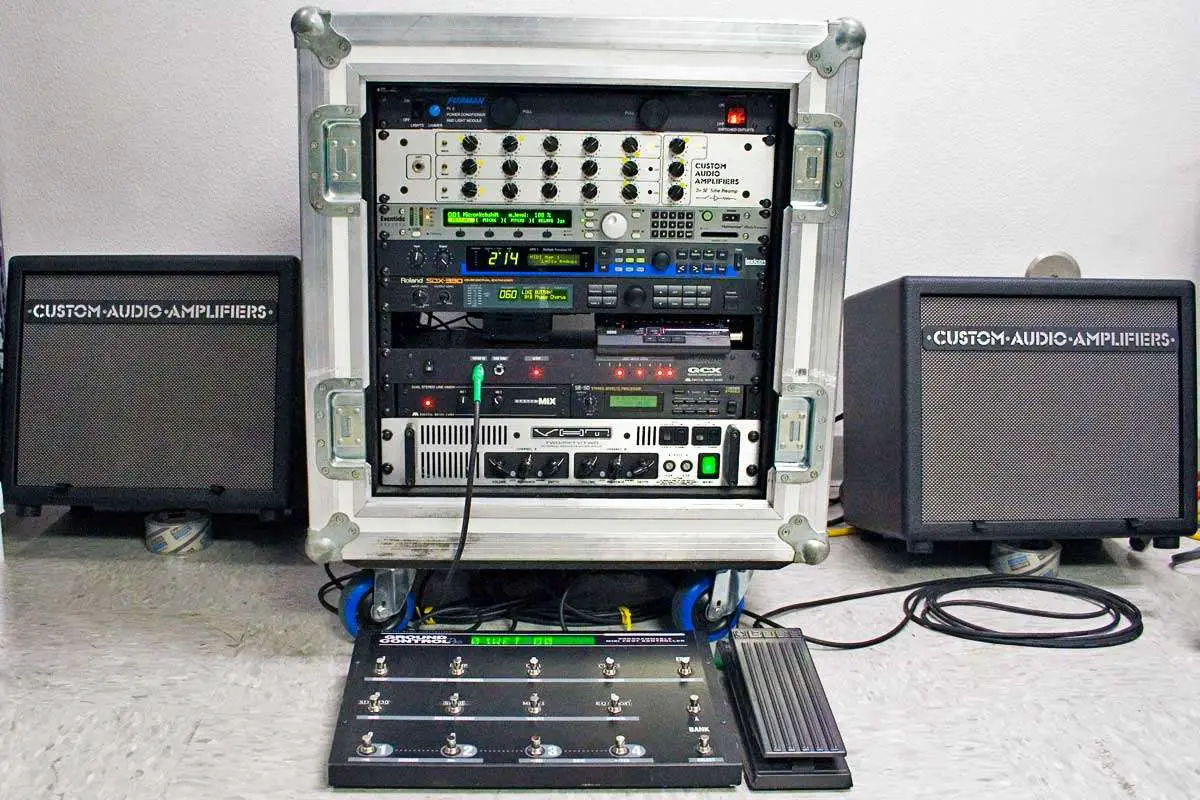
Innovations on the Horizon
The innovation in guitar pedals is set to continue with designers introducing more portable and versatile options. Innovations like the AirLoop-pedal represent steps towards non-contact signal processing, transforming how artists interact with their effects. Musicians can look forward to a surge of new devices that expand the capabilities of traditional stompboxes.
Integration with Emerging Technologies
Technology integration forms the crux of the future for guitar pedals, with digital technology blurring the lines between analog and digital realms. The incorporation of software that allows for profiling of tone and effects promises a revolutionary shift. For instance, devices are emerging that enable guitarists to store the sonic characteristics of their favorite setups, making a plethora of sounds accessible with the touch of a button. This melding of hardware and software ushers in a new era for guitar effects within the broader sphere of music production.
The Role of Pedals in Modern Music
Guitar pedals will maintain their vital role in the evolution of modern music. They are tools for creative expression, shaping sound in genres as diverse as indie rock and electronic music. As music continues to cross borders and genres, pedals provide a pallet of sonic textures that contribute to the genre-defying soundscapes of today’s music landscape. The future points towards an increased reliance on pedals for sound innovation, enabling musicians to push the boundaries of what is possible.
